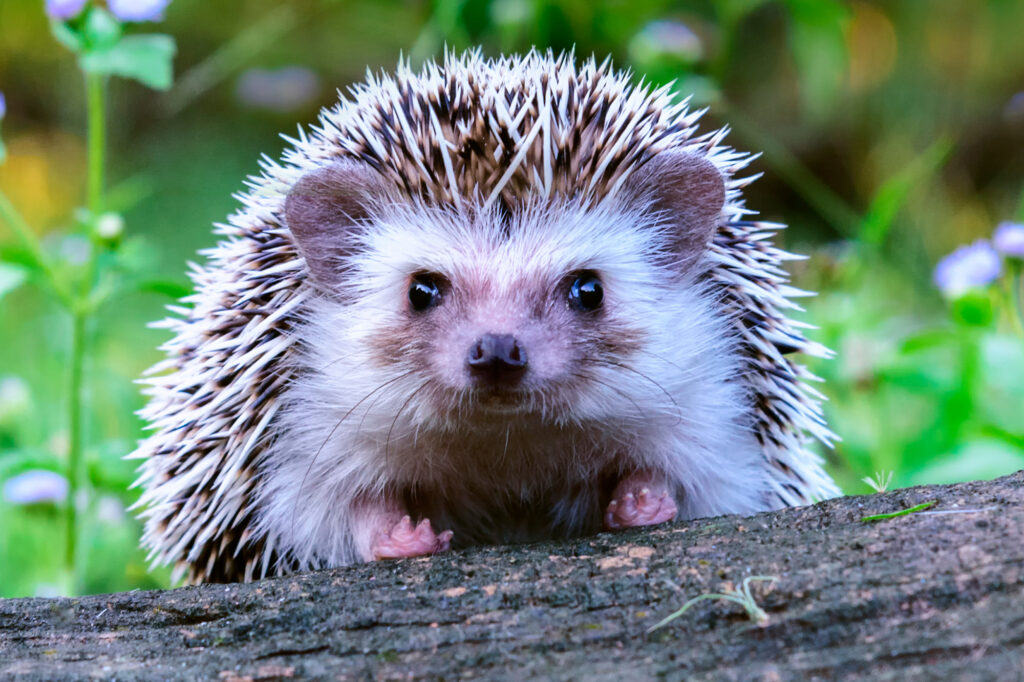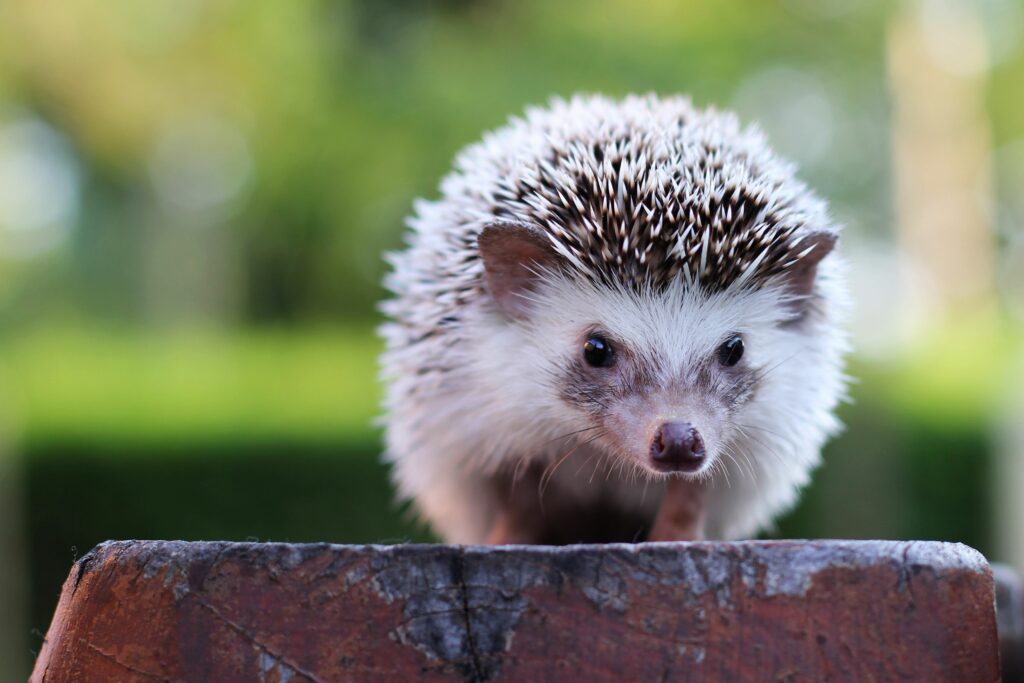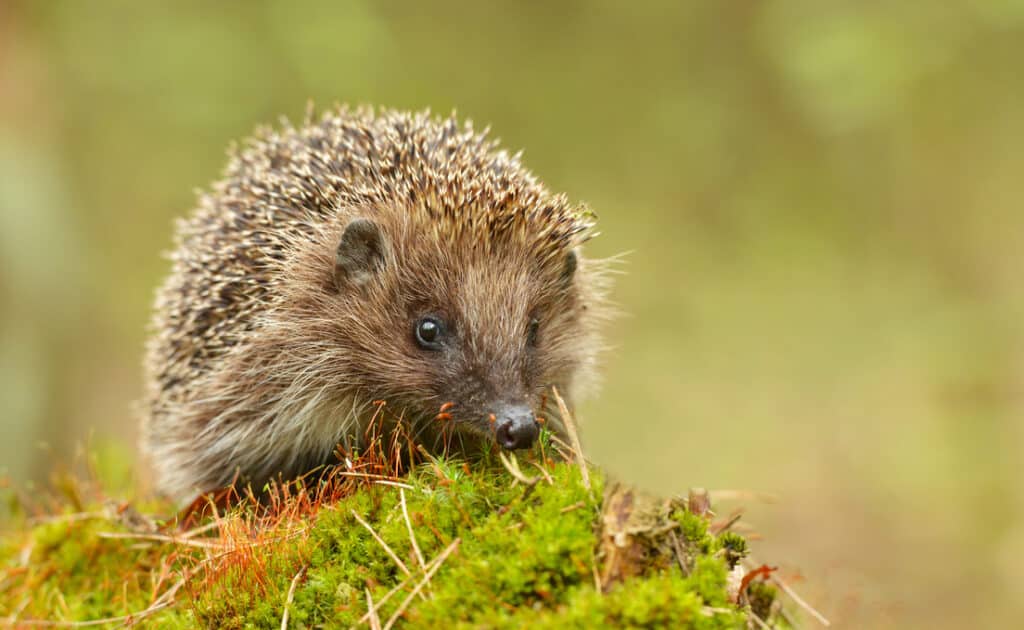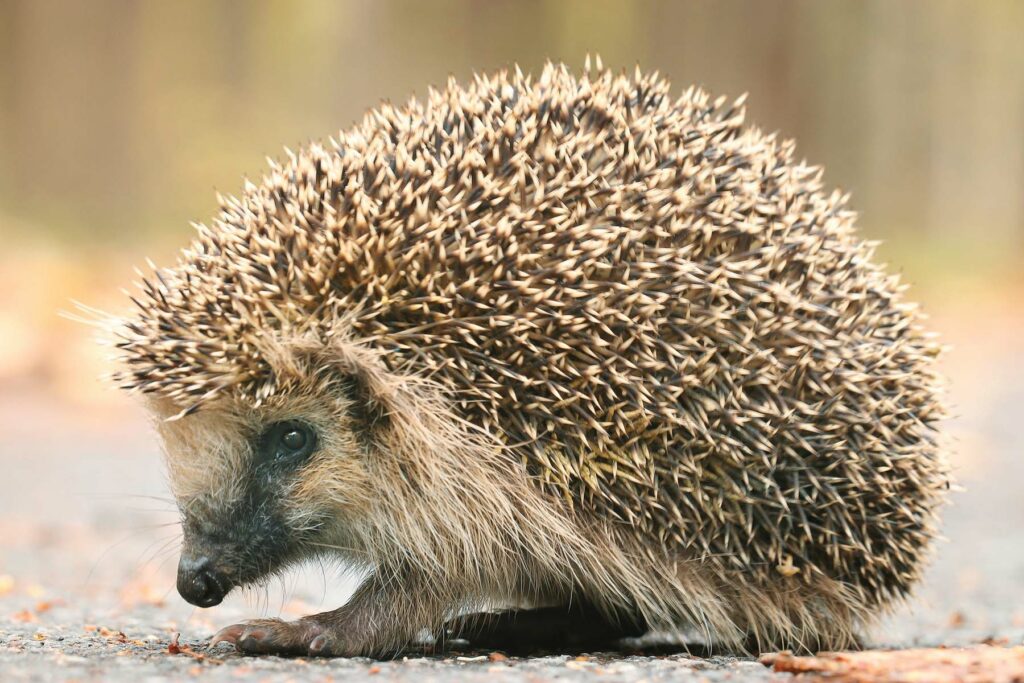Hedgehogs are among the most beloved and enigmatic animals found throughout the British countryside. These small, ground-dwelling creatures with their distinctive appearance and endearing behaviours have captured the hearts of many. This article will delve into the fascinating world of hedgehogs, including their unique characteristics, behaviours, and the essential role they play in the ecosystem. We will also explore how to care for these inquisitive animals and ensure their continued presence in our gardens and wildlife.
Understanding Hedgehogs: Physical Features and Species
Hedgehogs are small mammals, easily recognised by their spiny coat made of coarse hair, known as quills. These animals with spikes use their quills as a defensive mechanism, rolling into a complete ball of spikes when threatened. There are several hedgehog species, including the European hedgehog, the African hedgehog, the Desert hedgehog, the Indian hedgehog, and the long-eared hedgehog, among others. The Mediterranean hedgehog and the four-toed hedgehog are also interesting desert-dwelling types, showcasing the adaptability of this creature to different habitats.
In Britain, the European hedgehog (Erinaceus europaeus) is the native species. This animal has a brownish-grey coat with a white underside and an impressive sense of smell. Its small, black eyes, and round, inquisitive face make it a popular subject of admiration and affection.

Hedgehog Behaviour and Lifestyle
Hedgehogs are primarily nocturnal creatures, having reverse sleep schedules compared to humans. They sleep during the day in a day nest made of leaves, grass, and other nesting material, usually hidden under piles of leaves, logs, or bushes. During the night, they emerge to forage for food, using their keen sense of smell to locate various types of invertebrates such as insects, slugs, and worms, which make up the majority of their diet.
These solitary animals are also known for their peculiar mating rituals, including elaborate displays, vocalisations, and courtship dances. Baby hedgehogs, called hoglets, are born after a gestation period of around 35 days. The female creates a special maternity nest, which is often an attractive nest built with more extensive insulation and protection, to give birth and care for her young.
In the colder months, hedgehogs prepare for hibernation by building a hibernation nest, where they will sleep for several months. They rely on their fat reserves to survive this period of inactivity. However, during mild winters, some individual hedgehogs may wake up and venture out to find food and fresh water.
The Role of Hedgehogs in the Ecosystem
Hedgehogs play a crucial role in the ecosystem, acting as natural pest controllers by feeding on garden invertebrates. They also help with the decomposition of dead wildlife, breaking down organic matter and contributing to the recycling of nutrients in the soil. Hedgehogs are known to consume bird eggs, particularly those of ground-nesting birds, which can help maintain a balance in bird populations.
Despite their many benefits, hedgehog populations have declined in recent years, primarily due to habitat loss, fragmentation, and the increasing presence of roads and traffic. The decreasing number of hedgehogs has raised concerns among wildlife enthusiasts and conservationists, highlighting the need for increased efforts to protect these charming creatures.
Attracting and Caring for Hedgehogs in Your Garden
Gardens can provide an ideal habitat for hedgehogs, offering food, shelter, and safe spaces for nesting and hibernation. To create a garden for hedgehogs, consider incorporating the following features:
Hedgehog-friendly shelters
To provide safe and comfortable shelters for hedgehogs, consider placing hedgehog boxes or hedgehog houses in secluded, sheltered areas of your garden. These structures should have a small entrance to keep larger predators from entering and disturbing the hedgehogs. In addition to purpose-built shelters, you can create natural hiding spots for hedgehogs to build their nests by leaving piles of leaves, logs, or rocks in various areas throughout your garden.
Food and water sources
To keep hedgehogs hydrated and well-fed, place a shallow dish of water in your garden, particularly during dry spells. Hedgehogs will also appreciate supplementary food, such as cat food or specially formulated meaty hedgehog food, to support their diet. It is essential to avoid offering milk or yoghurt pots, as these can cause digestive problems for hedgehogs and negatively impact their health.
Safe spaces for foraging
Encourage a healthy population of garden invertebrates, which serve as a primary food source for hedgehogs, by avoiding the use of pesticides and creating a wildlife-friendly environment. Plant a variety of plants, flowers, and shrubs to support a diverse ecosystem in your garden. Additionally, you can leave piles of leaves, twigs, and logs scattered around the garden to create habitats for insects. This, in turn, will provide hedgehogs with ample food sources to support their foraging habits.
Access points
Ensuring that hedgehogs can move freely between gardens is crucial for their survival. Create small gaps or holes in fences, walls, or hedges to enable hedgehogs to roam in search of food and nesting sites. By allowing hedgehogs to access various garden spaces, you can significantly increase their chances of survival and contribute to the overall health of the hedgehog population.

Hedgehog Welfare: Looking After Injured or Underweight Hedgehogs
If you find an injured hedgehog, a juvenile hedgehog out during daylight hours, or an underweight hedgehog during the autumn months, it is essential to seek advice from an animal welfare organisation or a local hedgehog rescue centre. These experts can provide guidance on how to care for the disabled hedgehog and when to release it back into the wild.
It is important to handle hedgehogs gently, using gloves or a towel, to avoid injury from their sharp quills. Hedgehogs can be placed in a secure box with air holes, a soft towel, and a source of warmth, such as a hot water bottle wrapped in a towel, until further advice is obtained.
Hazards to Hedgehogs and How to Avoid Them
There are several hazards to hedgehogs in our gardens and neighbourhoods, including:
- Garden tools and machinery: Always check for hedgehogs before using lawnmowers, strimmers, or garden forks, as these can cause severe injuries or even death to hedgehogs hiding in the grass or piles of leaves.
- Pesticides and chemicals: Avoid using harmful chemicals in your garden, as these can poison hedgehogs and their food sources. Opt for natural alternatives such as coffee grounds or crushed eggshells to deter slugs and snails.
- Road traffic: Hedgehogs are at risk of being injured or killed by cars, particularly during their nocturnal foraging. Drive carefully, particularly at night and near known hedgehog habitats, and encourage your neighbours to do the same.
- Garden netting and litter: Loose netting, plastic bags, or discarded yoghurt pots can pose a hazard to hedgehogs, as they can become entangled or trapped. Keep your garden tidy and ensure that any potential hazards are safely secured or removed.
By taking these precautions and creating a hedgehog-friendly environment, you can help to protect these endearing wild animals and ensure their continued presence in our gardens and wildlife for years to come. With an understanding of hedgehog behaviour, their ecological role, and how to provide a safe and nurturing habitat, you can contribute to the conservation of these fascinating and inquisitive animals.
Hedgehog Conservation Efforts and Community Involvement
Protecting and preserving hedgehog populations is crucial for maintaining the delicate balance of our ecosystems. Several organisations and community groups are dedicated to the conservation of hedgehogs and raising awareness about their plight. You can support these initiatives by:
Joining a local hedgehog group
Many communities have hedgehog groups or wildlife organisations that focus on hedgehog conservation. Becoming a member of such a group allows you to share knowledge, resources, and efforts in creating a more hedgehog-friendly environment in your neighbourhood.
Participating in citizen science projects
Engage in projects that involve monitoring and recording hedgehog sightings, nest sites, and other relevant data. This information can be invaluable for researchers and conservationists in understanding hedgehog populations and their needs.
Advocating for hedgehog-friendly policies
Encourage local councils and policymakers to implement measures that protect hedgehogs and their habitats, such as installing hedgehog-friendly road crossings, preserving green spaces, and regulating the use of harmful chemicals in public areas.
Raising awareness and educating others
Share information about hedgehogs and their conservation with your friends, family, and community. Encourage others to create hedgehog-friendly gardens and take steps to protect these captivating creatures.

Learning More About Hedgehogs
There is always more to discover about the fascinating world of hedgehogs. By staying informed and curious about these animals, you can deepen your appreciation for their unique characteristics, behaviours, and contributions to our ecosystem. Some resources to explore include:
- Books and articles: Numerous books and articles have been written about hedgehogs, their natural history, and their conservation. These can provide valuable insights into their biology, ecology, and the challenges they face in the modern world.
- Documentaries and videos: Visual media can offer an engaging and informative look into the lives of hedgehogs, showcasing their behaviours, habitats, and the efforts being made to protect them.
- Wildlife centres and sanctuaries: Visiting a hedgehog rescue centre, a wildlife sanctuary, or a nature reserve can offer a unique, up-close experience with these charming creatures. These centres often provide educational resources and opportunities to learn more about hedgehog conservation and how you can help.
Hedgehog Myths and Misconceptions
There are several myths and misconceptions surrounding hedgehogs that can lead to misunderstandings about their behaviour, biology, and the best ways to care for them. It is essential to debunk these myths to ensure that our actions are based on accurate information and contribute positively to hedgehog welfare:
- Hedgehogs carry fleas: While hedgehogs can have fleas, the species of flea that infests hedgehogs is different from those that infest domestic pets. Hedgehog fleas (Archaeopsylla erinacei) are host-specific and do not pose a risk to humans or pets.
- Hedgehogs are related to porcupines: Despite their similar appearance, hedgehogs and porcupines are not closely related. Porcupines are rodents, while hedgehogs are part of the Erinaceidae family, a group of insectivorous mammals.
- Hedgehogs love milk and bread: This is a dangerous myth. Milk and bread can cause severe digestive problems for hedgehogs, potentially leading to illness or death. Instead, provide fresh water and meat-based pet food as supplementary sources of nourishment.
- Hedgehogs can shoot their quills: Hedgehogs cannot shoot or detach their quills. When threatened, they roll into a tight ball, using their spines as a defensive barrier against predators. The quills remain firmly attached to their skin and will only be shed and replaced as part of their natural growth cycle.
The Future of Hedgehogs
The decline in hedgehog populations across Britain and Europe highlights the need for collective action to protect these enchanting creatures. Through increased understanding, awareness, and practical measures, we can create a future where hedgehogs continue to thrive alongside humans.
By integrating hedgehog-friendly practices into our daily lives and advocating for their protection on a broader scale, we can make a meaningful difference in the lives of these captivating animals. The survival of hedgehogs depends on our ability to adapt our behaviours and habitats to accommodate their needs.
The story of hedgehogs serves as a reminder of our responsibility to protect and preserve our wildlife, ensuring a diverse and thriving ecosystem for generations to come. By embracing this responsibility, we can become active participants in the conservation of these endearing animals and contribute to a more sustainable and harmonious coexistence with the natural world.

Hedgehog FAQ’s
What Do Hedgehogs Eat?
Hedgehogs primarily eat invertebrates, such as insects, slugs, and worms. In your garden, you can provide supplementary food, such as meat-based cat food or specially formulated hedgehog food. Avoid giving them milk or bread, as these can cause digestive issues.
How Can I Attract Hedgehogs to My Garden?
To attract hedgehogs to your garden, provide safe shelters like hedgehog boxes, purpose-built hedgehog houses, or natural hiding spots with piles of leaves, logs, or rocks. Offer a shallow dish of water and supplementary food. Also, create small gaps in fences or walls to allow hedgehogs to roam freely between gardens.
Do Hedgehogs Hibernate?
Yes, hedgehogs hibernate during the colder months, usually between November and March. They build a hibernation nest, where they sleep for several months, relying on their stored fat reserves to survive this period of inactivity.
Are Hedgehogs Endangered?
Hedgehog populations have declined in recent years due to habitat loss, fragmentation, and road-related deaths. While they are not classified as endangered, their declining numbers are a cause for concern and highlight the need for increased conservation efforts.
How Can I Help an Injured or Underweight Hedgehog?
If you find an injured or underweight hedgehog, contact an animal welfare organisation or a local hedgehog rescue centre for advice. Handle the hedgehog gently using gloves or a towel, and place it in a secure box with air holes, a soft towel, and a source of warmth until you receive further guidance.
Are Hedgehogs Nocturnal?
Yes, hedgehogs are primarily nocturnal creatures, meaning they are active during the night and sleep during the day. They typically rest in a day nest made of leaves, grass, and other nesting materials.
Do Hedgehogs Carry Diseases?
Hedgehogs can carry ticks, fleas, and internal parasites, but they pose a minimal risk to humans and pets. Maintaining a clean environment and practicing good hygiene can help reduce any potential risks.
Can I Keep a Hedgehog as a Pet?
Some species of hedgehogs, like the African Pygmy hedgehog, can be kept as pets. However, European hedgehogs, which are native to Britain, are protected by law and should not be taken from the wild or kept as pets. Before considering a hedgehog as a pet, research their specific care requirements and consult with a knowledgeable veterinarian.
How Long Do Hedgehogs Live?
In the wild, the average lifespan of hedgehogs is 2-3 years, although some may live up to 5 years. Captive hedgehogs, such as African Pygmy hedgehogs, can live between 4-8 years, depending on their care and environment.
How Can I Help Hedgehog Conservation Efforts?
Support hedgehog conservation efforts by creating a hedgehog-friendly garden, joining a local hedgehog group, participating in citizen science projects, advocating for hedgehog-friendly policies, and raising awareness about hedgehogs and their conservation.
Additional Resources
Sam loves to learn about animals and their habitats. He has been a nature lover from a very young age, and has been writing papers and articles about wildlife for as long as he can remember.
